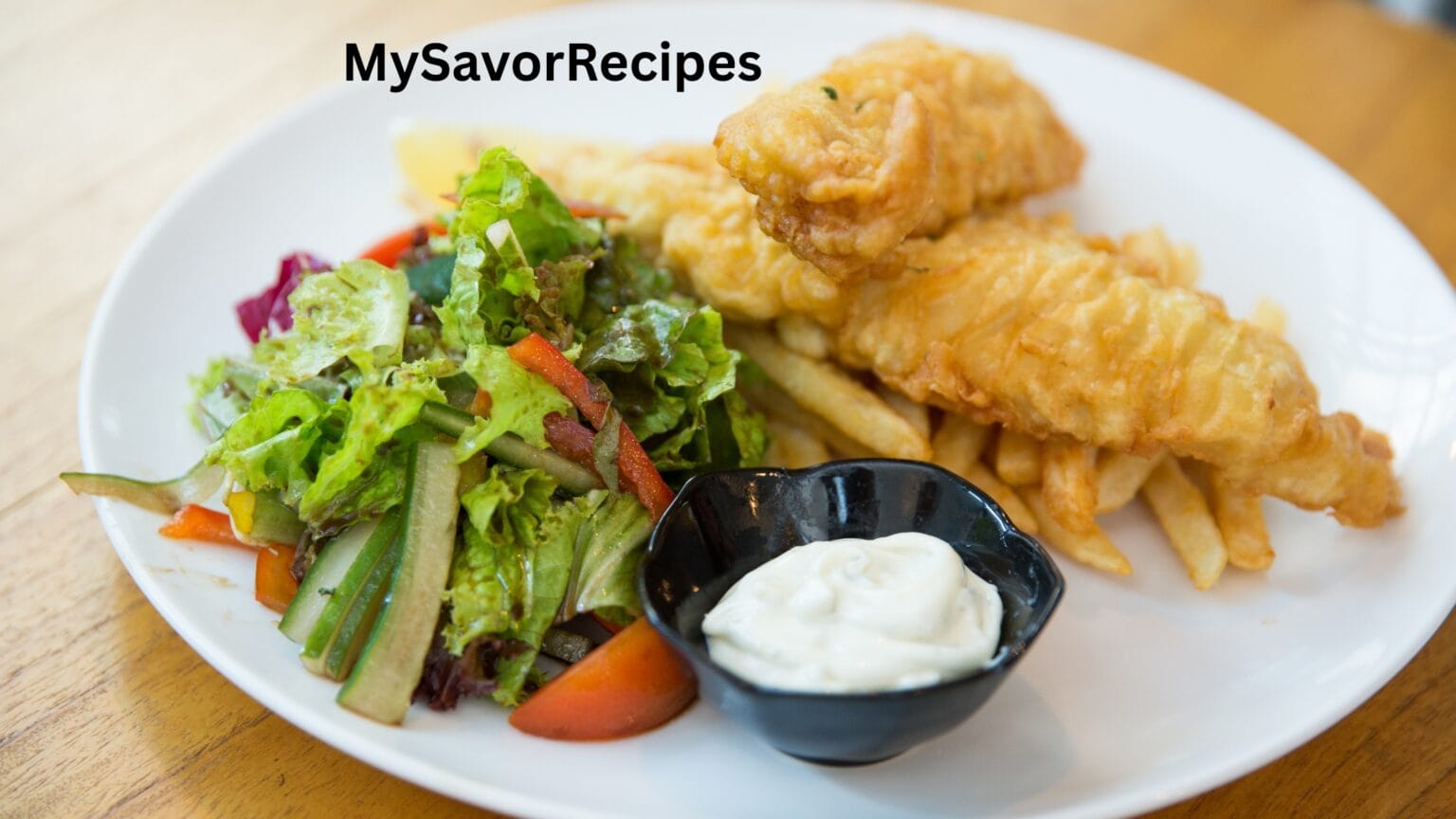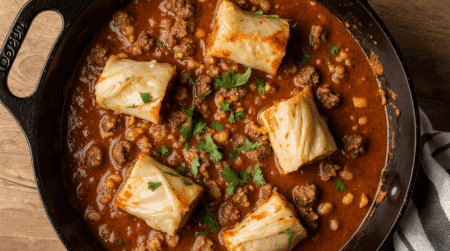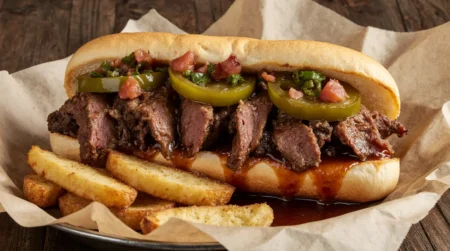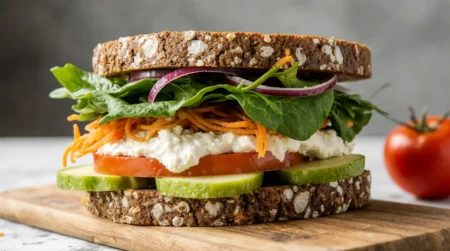Every bite of fish and chips tells a story of comfort, tradition, and culinary delight. Growing up, my family loved trying international foods. We discovered the magic of traditional British fish and chips early on.
The crispy golden batter, perfectly fried fish, and hot chips took me to London’s bustling streets. It was like a taste of home in every bite.
Fish and chips is more than a meal; it’s a cultural experience. It connects people through shared flavors and memories. Whether you love cooking or just want a delicious comfort food, this iconic British dish is special for everyone.
In this guide, you’ll learn how to make restaurant-quality fish and chips at home. We’ll cover everything from choosing the freshest ingredients to mastering cooking techniques. These secrets make this dish a timeless favorite.
Table of Contents
Key Takeaways
- Discover the rich cultural heritage of fish and chips
- Learn professional cooking techniques for perfect results
- Understand the art of selecting quality ingredients
- Explore traditional and modern preparation methods
- Gain insights into authentic British culinary traditions
The History and Heritage of Traditional Fish and Chips
Fish and chips are more than a classic dish in British cuisine. They tell a story of cultural change and culinary innovation over generations. This journey from humble beginnings to global comfort food is both fascinating and delicious.
The roots of this traditional British food go back to the 19th century’s industrial revolution. Working-class communities found an affordable, satisfying meal that was quick to make and easy to share.
Origins in Working-Class Culture
Fish and chips became a practical choice for hungry workers looking for nutritious, cheap meals. It became very popular in northern England’s industrial cities. Workers needed lots of energy for long factory shifts.
- First fish and chip shops appeared in the 1860s
- Quickly spread across industrial regions
- Became a staple for working-class families
Evolution into a Global Comfort Food
What began as a local British tradition grew into an international phenomenon. Immigrants took the recipe around the world, adapting it to local tastes but keeping its core essence.
Traditional Preparation Methods
Making authentic fish and chips requires techniques passed down through generations. It involves choosing fresh fish, making a crispy batter, and frying at precise temperatures. This creates the perfect golden-brown texture.
“A good fish and chip meal is an art form, not just a meal” – Traditional British Chef
What Makes the Perfect Fish and Chips
Making the best fish and chips is an art. It needs the right ingredients, cooking skills, and a love for flavor. Whether you cook at home or love food, knowing the key parts of this dish can make your fried fish better.
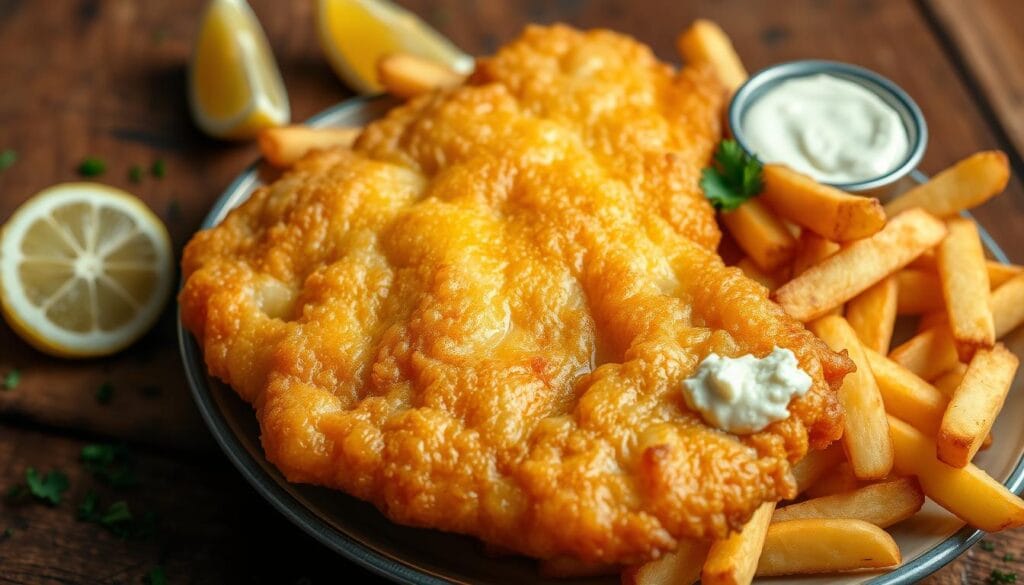
Selecting the Freshest Fish
The best fried fish starts with the right seafood. Choose white fish like cod, haddock, or halibut. They have a light flavor and firm texture. Here’s what to look for when picking fish for your fish and chips:
- Fresh, ocean-caught fish with clear eyes
- Firm, translucent flesh without discoloration
- Minimal fishy smell
- Sourced from reputable local fishmongers
The Art of Crispy Batter
A perfect batter makes your fried fish amazing. It’s about a light, crispy coating that goes well with the fish. Chefs say a beer batter or tempura mix is the best for crispiness.
- Use cold sparkling water or beer for lightness
- Mix flour with minimal handling
- Rest the batter for 30 minutes before cooking
- Ensure oil is at the right temperature (around 350°F)
Mastering Golden Chip Perfection
Crispy fries are key with fried fish. Use starchy potatoes like Russet or Maris Piper for the best taste. Double-frying is essential for those golden, crispy fries that make fish and chips so loved.
- Cut potatoes into uniform thick-cut chips
- Soak cut potatoes in cold water to remove excess starch
- First fry at lower temperature (325°F)
- Second fry at higher temperature (375°F) for crispiness
Essential Ingredients for Authentic Fish and Chips
Making the perfect fish and chips starts with the right ingredients. You need to pick the best seafood and potatoes. This turns a simple meal into a masterpiece.
For the fish, choose white-fleshed fish for great taste and texture. The top picks are:
- Cod – the classic choice for fish and chips
- Haddock – a flavorful alternative with delicate meat
- Pollock – a sustainable seafood option
Choosing the right potatoes is key for the chips. Look for starchy types that get crispy:
- Maris Piper potatoes
- King Edward potatoes
- Russet potatoes
The batter is another important part. It should be light, crispy, and golden. Traditional recipes often use a simple mixture of flour, beer, and seasonings for that perfect crunch.
Adding the right sides makes the dish even better. Mushy peas, tangy tartar sauce, and malt vinegar add to the British flavor.
Secret Techniques for Restaurant-Quality Results
Mastering fish and chips is more than basic cooking. Professional chefs use precision and technique for crispy fries and golden fish. These secrets will make your home cooking as good as a restaurant.
Temperature Control Tips for Perfect Frying
Temperature is key for fish and chips. The ideal oil temperature is 350-375°F for a crispy exterior. Use a deep-fry thermometer to keep the heat steady. Fluctuating temperatures can make the fish and fries greasy and soggy.
- Use a neutral oil with a high smoke point like vegetable or peanut oil
- Let the oil heat up slowly and stabilize before adding food
- Avoid overcrowding the frying pan to keep the temperature right
Batter Consistency Secrets
Making the perfect batter is an art. You want a light, airy texture that sticks to the fish without being heavy. Cold sparkling water and cornstarch help create a crisp, delicate coating.
| Ingredient | Purpose | Recommended Amount |
|---|---|---|
| Flour | Base of batter | 1 cup |
| Cornstarch | Adds crispiness | 2 tablespoons |
| Sparkling water | Creates light texture | 3/4 cup |
The Double-Frying Method
Professional chefs use the double-frying technique for ultimate crispiness. This method fries at two temperatures. It makes the exterior golden-brown and keeps the inside moist.
- First fry: Cook at a lower temperature (325°F) for 3-4 minutes
- Let food rest for a few minutes
- Second fry: Increase temperature to 375°F for 1-2 minutes
By using these professional techniques, you’ll make your fish and chips restaurant-quality. Remember, practice makes perfect. Don’t get discouraged if it takes a few tries.
Classic Accompaniments and Sides
Enjoying traditional British food is better with the right sides. These classic sides make fish and chips unforgettable. They add depth and variety to every bite.
Classic fish and chips come with several iconic sides. These sides are key to the traditional British dish:
- Mushy Peas: A quintessential side that adds vibrant green color and creamy texture
- Pickled Onions: Tangy and sharp, providing a zesty contrast
- Curry Sauce: A modern twist that brings spicy complexity
- Tartar Sauce: Creamy and slightly acidic
Regional variations change the sides served with fish and chips. Coastal towns often have unique local additions. These reflect their culinary heritage.
| Accompaniment | Flavor Profile | Origin |
|---|---|---|
| Mushy Peas | Creamy, Mild | Northern England |
| Curry Sauce | Spicy, Complex | British-Indian Fusion |
| Pickled Onions | Tangy, Sharp | Traditional British Pub Culture |
“A proper fish and chips meal isn’t complete without its classic sides!” – British Food Enthusiasts
Whether you love traditional or new flavors, trying these sides is a must. Each side adds its own special touch to the classic fish and chips experience.
Finding the Best Fish and Chip Shop Near You
Finding a great fish and chip shop can change how you enjoy seafood. The best places offer more than just food. They take you on a journey of traditional cooking and fresh ingredients.
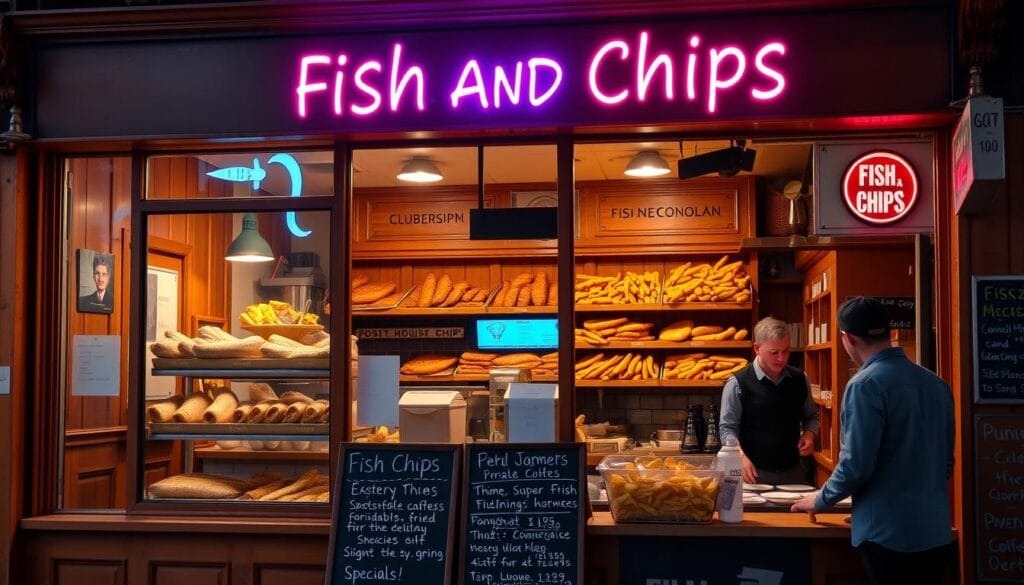
Looking for the best fish and chips in your area? There are important things to consider.
Quality Indicators to Look For
Finding a top fish and chip shop takes some effort. Look for these key signs:
- Fresh, locally sourced seafood
- Crispy, golden-brown batter
- Clean, well-maintained kitchen area
- High customer turnover indicating popularity
- Transparent cooking processes
Reading Reviews and Ratings
Online reviews give you a good idea of a shop’s reputation. Look for:
- Taste and texture of fish
- Chip quality and crispiness
- Customer service
- Portion sizes
- Overall value for money
Questions to Ask Your Local Chippy
Before choosing, talk to the staff and ask important questions:
- Where do you source your fish?
- How often do you change your cooking oil?
- What type of fish do you use for your signature dish?
- Do you offer any sustainable seafood options?
By using these tips, you’ll find a fantastic fish and chip shop. It will give you a real, tasty seafood experience.
Health-Conscious Options and Alternatives
Seafood doesn’t have to be bad for your health. Traditional British dishes can be made healthier with smart cooking. This way, you can enjoy tasty food without the guilt.
Here are some healthy swaps for fish and chips:
- Baking instead of deep-frying to cut down on oil content
- Using air fryers for crispy texture with minimal oil
- Selecting leaner fish varieties like cod or haddock
- Exploring gluten-free batter options
Changing how you make this classic dish can make it healthier. Try using whole wheat flour, almond meal, or panko breadcrumbs. These can make your meal more nutritious.
| Cooking Method | Calories | Fat Content |
|---|---|---|
| Deep Fried | 480 | High |
| Baked | 320 | Low |
| Air Fried | 350 | Moderate |
Don’t forget about your side dishes. Try roasted sweet potato wedges or a fresh green salad. These can make your meal even healthier.
Conclusion
Your journey into the world of fish and chips is more than just a meal. It’s a way to connect with generations and cultures. Whether making it at home or finding the best spot, you’ve learned a lot about this dish.
Learning about the techniques, ingredients, and cultural importance changes how you see this classic. You now know how to make it even better. You can make your fish and chips taste like it’s from a restaurant.
Fish and chips are always changing but stay true to their roots. They mix old cooking ways with new ideas. Now, you can explore and enjoy this dish in many ways.
Great fish and chips are about more than just how you make it. It’s about the love, quality, and sharing a meal that brings people together. With your new skills, you’re ready to enjoy this amazing tradition.

